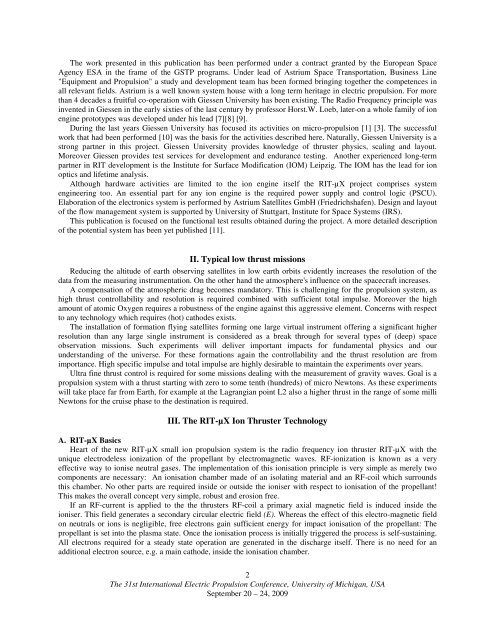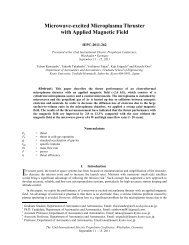Design Development and Test of the RIT-ÁX Mini Ion Engine System
Design Development and Test of the RIT-ÁX Mini Ion Engine System
Design Development and Test of the RIT-ÁX Mini Ion Engine System
Create successful ePaper yourself
Turn your PDF publications into a flip-book with our unique Google optimized e-Paper software.
The work presented in this publication has been performed under a contract granted by <strong>the</strong> European Space<br />
Agency ESA in <strong>the</strong> frame <strong>of</strong> <strong>the</strong> GSTP programs. Under lead <strong>of</strong> Astrium Space Transportation, Business Line<br />
"Equipment <strong>and</strong> Propulsion" a study <strong>and</strong> development team has been formed bringing toge<strong>the</strong>r <strong>the</strong> competences in<br />
all relevant fields. Astrium is a well known system house with a long term heritage in electric propulsion. For more<br />
than 4 decades a fruitful co-operation with Giessen University has been existing. The Radio Frequency principle was<br />
invented in Giessen in <strong>the</strong> early sixties <strong>of</strong> <strong>the</strong> last century by pr<strong>of</strong>essor Horst.W. Loeb, later-on a whole family <strong>of</strong> ion<br />
engine prototypes was developed under his lead [7][8] [9].<br />
During <strong>the</strong> last years Giessen University has focused its activities on micro-propulsion [1] [3]. The successful<br />
work that had been performed [10] was <strong>the</strong> basis for <strong>the</strong> activities described here. Naturally, Giessen University is a<br />
strong partner in this project. Giessen University provides knowledge <strong>of</strong> thruster physics, scaling <strong>and</strong> layout.<br />
Moreover Giessen provides test services for development <strong>and</strong> endurance testing. Ano<strong>the</strong>r experienced long-term<br />
partner in <strong>RIT</strong> development is <strong>the</strong> Institute for Surface Modification (IOM) Leipzig. The IOM has <strong>the</strong> lead for ion<br />
optics <strong>and</strong> lifetime analysis.<br />
Although hardware activities are limited to <strong>the</strong> ion engine itself <strong>the</strong> <strong>RIT</strong>-µX project comprises system<br />
engineering too. An essential part for any ion engine is <strong>the</strong> required power supply <strong>and</strong> control logic (PSCU).<br />
Elaboration <strong>of</strong> <strong>the</strong> electronics system is performed by Astrium Satellites GmbH (Friedrichshafen). <strong>Design</strong> <strong>and</strong> layout<br />
<strong>of</strong> <strong>the</strong> flow management system is supported by University <strong>of</strong> Stuttgart, Institute for Space <strong>System</strong>s (IRS).<br />
This publication is focused on <strong>the</strong> functional test results obtained during <strong>the</strong> project. A more detailed description<br />
<strong>of</strong> <strong>the</strong> potential system has been yet published [11].<br />
II. Typical low thrust missions<br />
Reducing <strong>the</strong> altitude <strong>of</strong> earth observing satellites in low earth orbits evidently increases <strong>the</strong> resolution <strong>of</strong> <strong>the</strong><br />
data from <strong>the</strong> measuring instrumentation. On <strong>the</strong> o<strong>the</strong>r h<strong>and</strong> <strong>the</strong> atmosphere's influence on <strong>the</strong> spacecraft increases.<br />
A compensation <strong>of</strong> <strong>the</strong> atmospheric drag becomes m<strong>and</strong>atory. This is challenging for <strong>the</strong> propulsion system, as<br />
high thrust controllability <strong>and</strong> resolution is required combined with sufficient total impulse. Moreover <strong>the</strong> high<br />
amount <strong>of</strong> atomic Oxygen requires a robustness <strong>of</strong> <strong>the</strong> engine against this aggressive element. Concerns with respect<br />
to any technology which requires (hot) cathodes exists.<br />
The installation <strong>of</strong> formation flying satellites forming one large virtual instrument <strong>of</strong>fering a significant higher<br />
resolution than any large single instrument is considered as a break through for several types <strong>of</strong> (deep) space<br />
observation missions. Such experiments will deliver important impacts for fundamental physics <strong>and</strong> our<br />
underst<strong>and</strong>ing <strong>of</strong> <strong>the</strong> universe. For <strong>the</strong>se formations again <strong>the</strong> controllability <strong>and</strong> <strong>the</strong> thrust resolution are from<br />
importance. High specific impulse <strong>and</strong> total impulse are highly desirable to maintain <strong>the</strong> experiments over years.<br />
Ultra fine thrust control is required for some missions dealing with <strong>the</strong> measurement <strong>of</strong> gravity waves. Goal is a<br />
propulsion system with a thrust starting with zero to some tenth (hundreds) <strong>of</strong> micro Newtons. As <strong>the</strong>se experiments<br />
will take place far from Earth, for example at <strong>the</strong> Lagrangian point L2 also a higher thrust in <strong>the</strong> range <strong>of</strong> some milli<br />
Newtons for <strong>the</strong> cruise phase to <strong>the</strong> destination is required.<br />
III. The <strong>RIT</strong>-µX <strong>Ion</strong> Thruster Technology<br />
A. <strong>RIT</strong>-µX Basics<br />
Heart <strong>of</strong> <strong>the</strong> new <strong>RIT</strong>-µX small ion propulsion system is <strong>the</strong> radio frequency ion thruster <strong>RIT</strong>-µX with <strong>the</strong><br />
unique electrodeless ionization <strong>of</strong> <strong>the</strong> propellant by electromagnetic waves. RF-ionization is known as a very<br />
effective way to ionise neutral gases. The implementation <strong>of</strong> this ionisation principle is very simple as merely two<br />
components are necessary: An ionisation chamber made <strong>of</strong> an isolating material <strong>and</strong> an RF-coil which surrounds<br />
this chamber. No o<strong>the</strong>r parts are required inside or outside <strong>the</strong> ioniser with respect to ionisation <strong>of</strong> <strong>the</strong> propellant!<br />
This makes <strong>the</strong> overall concept very simple, robust <strong>and</strong> erosion free.<br />
If an RF-current is applied to <strong>the</strong> <strong>the</strong> thrusters RF-coil a primary axial magnetic field is induced inside <strong>the</strong><br />
ioniser. This field generates a secondary circular electric field (E). Whereas <strong>the</strong> effect <strong>of</strong> this electro-magnetic field<br />
on neutrals or ions is negligible, free electrons gain sufficient energy for impact ionisation <strong>of</strong> <strong>the</strong> propellant: The<br />
propellant is set into <strong>the</strong> plasma state. Once <strong>the</strong> ionisation process is initially triggered <strong>the</strong> process is self-sustaining.<br />
All electrons required for a steady state operation are generated in <strong>the</strong> discharge itself. There is no need for an<br />
additional electron source, e.g. a main cathode, inside <strong>the</strong> ionisation chamber.<br />
2<br />
The 31st International Electric Propulsion Conference, University <strong>of</strong> Michigan, USA<br />
September 20 – 24, 2009






